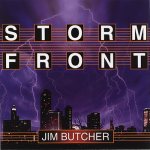
Editor’s Note: Let’s give a big hand to our newest reviewer, Michael Bekemeyer. When Michael isn’t writing screenplays and shooting pictures, he writes and reads his own stories on his podcast, Scatterpod.
 Storm Front: Book 1 of the Dresden Files
Storm Front: Book 1 of the Dresden Files
By Jim Butcher; Read by James Marsters
1 MP3 Disc or 8 CDs – Approx. 10.5 hrs [UNABRIDGED]
Publisher: Buzzy Multimedia
Published: 2004
ISBN: 0965725561(MP3 disc); 0965725502(CDs)
Themes: / Fantasy / Mystery / Magic / Private Detective / Wizard / Noir /
Fans of the Dresden series of books will probably recognize this title as the first in the widely successful series authored by Jim Butcher. Those of you who have been living under a rock somewhere, like I have, might only have known this as a TV series on the Sci-Fi Channel. Either way, once introduced to the world of Harry Blackstone Copperfield Dresden, you are most likely to find yourself under his spell and wanting more.
If first impressions count the most, you might not think much of Harry Dresden. He is the classic underdog; a private investigator complete with a sagaciously dry sense of humor, a cat called Mr., a car that breaks down more than it runs and oh, yes, magical powers. That’s right, he’s a wizard and a P.I. and therein lies the charm of this series.
The story starts like a lot of detective stories. The unlikely hero is hired by a seemingly normal client, who is trying to find her missing husband and the mystery that is woven is tight and spellbinding, as well as thoughtful and told in first person. So we, the reader (or listener) find things out as Dresden does and are never allowed the luxury of knowing what’s going on before he does.
Sounds pretty cut and dry, I know, but as the mystery unfolds we are introduced to a holistically inventive cast of characters that includes vampires, demons, giant scorpions, a dark wizard, prostitutes, fairies, drug dealers, gangsters, a nymphomaniac and even a peeping-pizza-delivery-guy-Tom. Each of these characters adds to the story and texture of the Dresden universe with richly orchestrated layers of darkness, humor and a never-ending sense of impending doom. And, since being underestimated is part of Dresden’s charm, we find that he has more than just a few card tricks up his sleeve.
The story is narrated by James Marsters, who you will most certainly know as Spike from Buffy the Vampire Slayer television series. His dry reading of the text does an excellent job of expressing the internal monologue of Harry Dresden. Since the story in first person, from the perspective of the main character, Marsters does not do a lot of voices, or interpretation of the characters. I think, as an actor, he may have been more inclined to capture the dramatic truth of the moment as opposed to using animated voices to tell the tale. So, it feels like we are gathered around a campfire while Dresden is personally recounting the details of the story for us.
The production value of this audio book is high, with rich sound that is full and easy to listen to. However, there were a few minor things that stood out to me. At times the reading sounded rushed. For instance, there are several times when the narrator almost flubs a line and doesn’t stop to correct himself. Also, there were several times when the background noise and page turns really jumped out at me. I know it may sound a bit picky to mention such things, but the beauty of listening to a story in audio form, is that the listener can enter the audible world of the story. Even the slightest glitch can instantly kill the mood.
All in all, I highly recommend this audiobook. I am happy to say that the hiccups in the production do not deteriorate the stellar performance and storytelling that you will find in Storm Front, Dresden Book 1. So, if you haven’t already found yourself under Dresden’s spell, this audio presentation by Buzzy Multimedia is a fine place to start.





